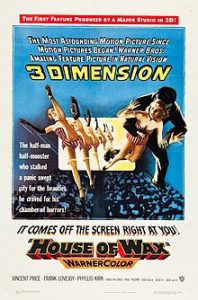House of Wax-1953
Director Andre De Toth
Starring Vincent Price, Phyllis Kirk
Scott’s Review #1,081
Reviewed November 13, 2020
Grade: B+
House of Wax (1953) is a classic horror film that should be seen by anyone who enjoys the genre. Its macabre elements make it a must-see.
Be sure to watch the 1953 version, not the mediocre 2005 remake that starred Paris Hilton with a severely changed storyline.
Interestingly, the 1950s version is a remake of the 1933 film Mystery of the Wax Museum, which I was unaware of until recently.
Pre-code 1930s horror is brilliant, so I cannot wait to watch this offering soon.
The production has the honor of being the first color 3-D film released by a major film studio, and the result is stylish and impressive for that early stage of cinema. If this isn’t enough, Vincent Price also stars.
With these riches, one could anticipate a masterpiece like Frankenstein (1931) or King Kong (1933). It’s not entirely on that level with a B-movie vibe that rises immensely in respectability with exquisite human art, a chilling premise, and a lesson about historical figures of long ago.
The film is a very short eighty-eight minutes.
The haunting and atmospheric opening titles immediately showcase the 3-D appearance in the first shot alongside a rainy and dreary New York City set in the early 1900s.
Director Andre De Toth confirms to his audience that it’s a 3-D film with the bold title leaping out of the screen within seconds. This sets the tone perfectly as the illustrious wax museum set is up next.
Wax creations like Marie Antoinette, John Wilkes Booth, and Joan of Arc pose in the vast gallery.
Henry Jarrod (Price) is a Professor who views his creations as his children, each unique and human-like to him. Marie is his ultimate masterpiece, and one wonders if she is his fantasy wife. His business partner, Burke (Roy Roberts), wants out of their partnership and takes drastic measures to gain insurance money. He sets fire to the museum, which burns to the ground, horribly disfiguring Henry.
The Professor goes off the deep end and rebuilds the museum using real human beings that he steals from the morgue! Frankenstein’s influence is evident.
Besides Price, the star is the wax museum, almost a character, but never upstages Price. Henry is sympathetic and menacing, and I felt sorry for the guy. Not only is his house of wax destroyed, but he has a disfigured face for life. His insurance policy benefit is of little comfort, nor is killing the man responsible for his misfortune.
We should root for the main couple, Sue Allen (Phyllis Kirk) and Scott Andrews (Paul Picerni), and attempt to understand why the wax figures look like dead people they know.
They are not the most substantial element of the film, though. Like other famous horror villains, Norman Bates and Hannibal Lecter, Henry is appealing, and we like him.
I would have liked to learn more about Henry before his ruination. Besides a brief tour of his museum, where he cleverly describes each work, we don’t know much about his life. He is creepy, but what else? Has he ever married? What are his parents like?
Charles Bronson and Carolyn Jones have minor roles as Henry’s mute assistant, Igor, and Burke’s gold-digging girlfriend, Cathy, respectively. This is fun since both went on to legendary careers in film and television.
A must-see for anyone studying cinematic technique or good horror trimmings, House of Wax (1953) contains state-of-the-art effects for the time, illuminating gas-lit streets of New York City, and a finale that includes a boiling hot vat of molten wax (what else!) that inspired a James Bond film.
These facets are lovely, but any horror film starring Vincent Price is worth the price of admission.
